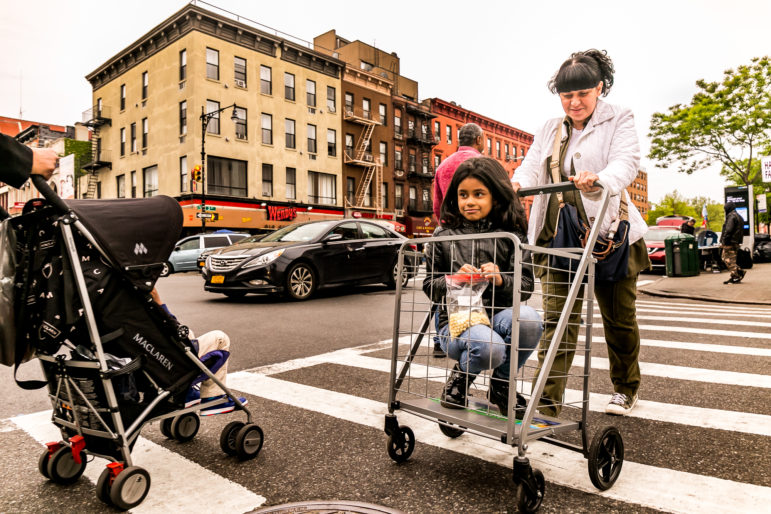
Adi Talwar
Lifelong East Harlem resident Joanne Rodriguez with her niece at the intersection of 116 Street and 3rd Avenue. Both rezoning plans would permit higher buildings on 3rd, but the Speaker's allies say their plan would yield more affordability and less density.
Haga clic aquí para obtener una versión en español de este artículo.
* * *
The Department of City Planning (DCP)’s proposed rezoning of East Harlem has entered the seven-month public review process known as the Uniform Land Use Review Procedure (ULURP)—touching off a period of intense debate over whether the City Council should adopt the de Blasio administration proposal, choose one backed by Council Speaker Melissa Mark-Viverito or, as some advocates hope, do neither.
East Harlem is the third of about a dozen potential neighborhood rezonings that the de Blasio administration has taken into the formal land-use review process. East New York was rezoned a year ago and a plan to rezone Downtown Far Rockaway is in the pipeline now.
City Hall says the rezonings will drive investment into neighborhoods, improving public infrastructure and creating new housing—some of it income-restricted—to alleviate the affordability crunch. But skeptics believe rezonings might exacerbate the housing crisis by creating an incentive for property owners to displace low-income people.
In East Harlem, the recently released Draft Environmental Impact Statement states that the rezoning is expected to encourage the creation of 3,488 units of housing and 1,543 permanent jobs in an area roughly bounded by East 104th Street, East 132nd street, 2nd Avenue and Park Avenue.
The document also notes that those totals are even higher when you add in the 100 percent rent-restricted development planned for the city-owned 111th Street Ballfields site, which is slated to bring another 655 units and 531 jobs to the rezoning area. The site-specific development proposal also entered ULURP late last month.
According to DCP planners at a presentation to the City Planning Commission on April 24, the rezoning aims to address multiple objectives: Relieve real-estate pressures in the area by creating rent-restricted housing through the application of the city’s mandatory inclusionary housing policy, promote economic development especially near transit nodes, preserve the character of certain blocks, create a zoning framework that makes provisions for future infrastructure needs, and use “urban design controls”—a set of nuanced regulations—to meet a variety of neighborhood goals.
of the
East Harlem Rezoning
The mandatory inclusionary housing rule requires developers who take advantage of a rezoning restrict rents on a set share of the new apartments, so that particular income groups can be served.
The Draft Environmental Impact Statement found that the rezoning would not have a “significant adverse impact” on direct or indirect residential and business displacement. But critics say the city’s environmental review method underestimates the number of sites that could be demolished for development and the potential for rising rents.
DCP emphasizes their proposal is the result of careful consideration of the East Harlem Neighborhood Plan, a comprehensive, multi-topic proposal crafted by a team of steering committee members appointed by City Council Speaker Melissa Mark-Viverito. The Neighborhood Plan calls for allowing buildings higher than are now permitted but lower than what the mayor wants, 100-percent rent-restricted housing on public sites and various initiatives to preserve affordability in existing housing.
The Neighborhood Plan has the support of key stakeholders like the Manhattan Borough President, Gale Brewer, and Community Voices Heard—although CVH has pushed for the Neighborhood Plan to be more aggressive in serving lower-income people.
But some organizations support neither plan. El Barrio Unite calls instead for both preservation efforts and the creation of deeply affordable housing. Movement for Justice in El Barrio has laid out a 10-point agenda calling for tougher enforcement of the housing code, more efforts to make tenants aware of the protections that exist and better oversight of the city’s code enforcement agency, HPD.
In the end, Mark-Viverito will have the final vote on the future of East Harlem before she is termed out of office at the end of 2017.
A key point in the discussion comes on Tuesday, May 16, at a public hearing called by Community Board 11. The meeting is at 6:30 p.m. at the Siberman School of Social Work at Hunter College, 2180 3rd Avenue.









2 thoughts on “Major Hearing Tuesday on East Harlem Rezoning”
The City has an acward history on rezoning. The displacement of communities.. i.e. Lincoln Center… Co Op City… 110th street and Frederick Douglas Ave. I am a homeowner and my residence to an uncontrolled Bloomberg strategies has destroyed communities i did treasure… And disinfranchised citizens and myself.
CVH needs a monitoring group sitting at the table insuring that low income housing is a reality. Furthernore they must review all exclusionary issues that impact on eligibility ie credit status and criminal issues. This has to be done know.